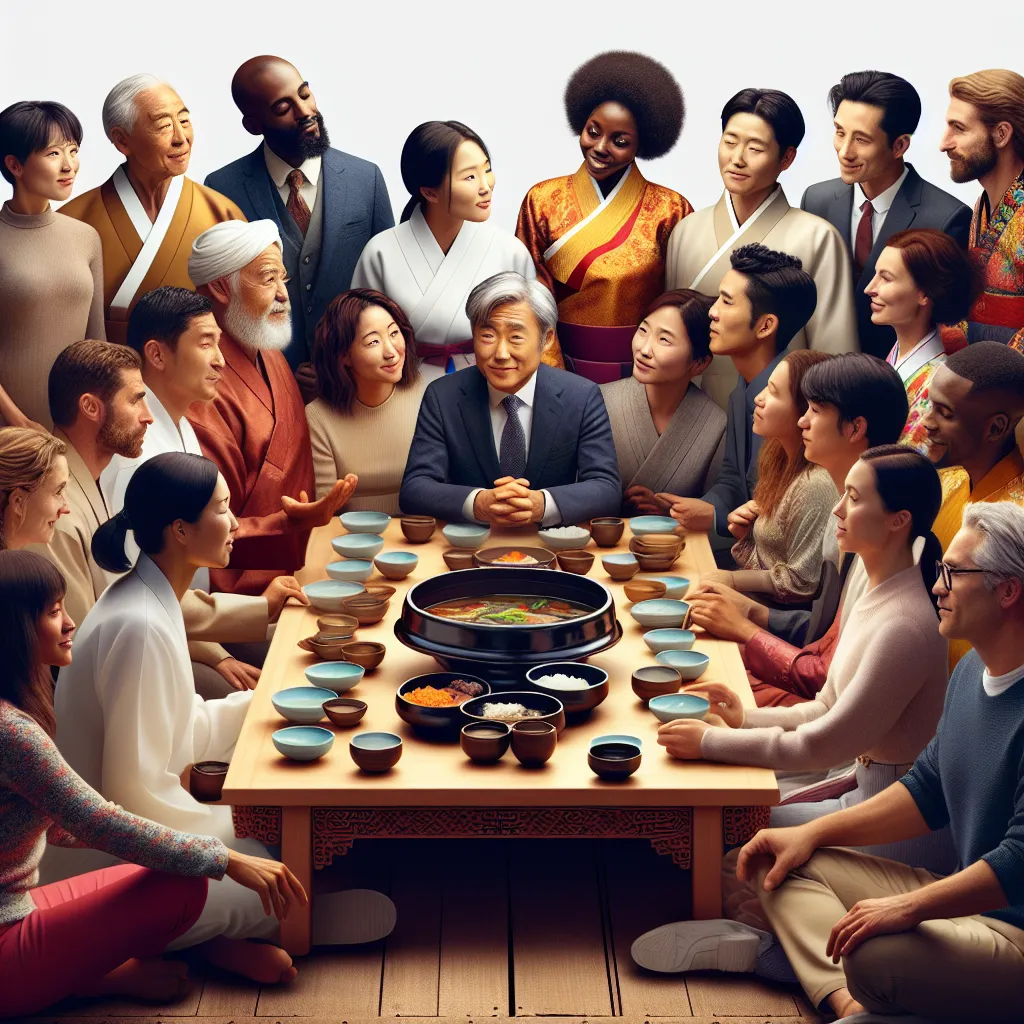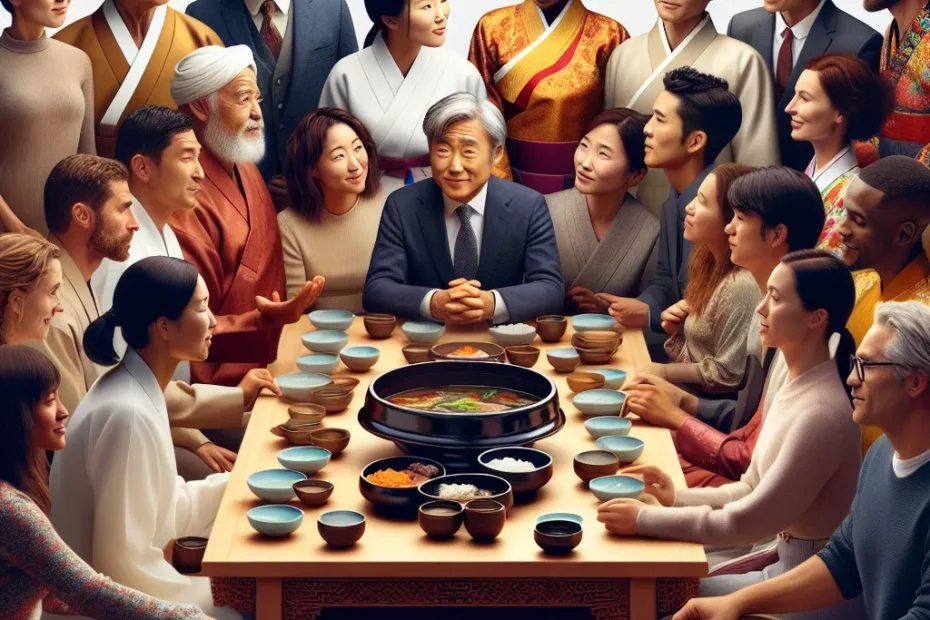Adjusting to a new culture can be both exciting and challenging. When it comes to Korea, the unique social norms and etiquette can sometimes be overwhelming for newcomers. From hierarchical structures to dining etiquette and communication styles, there’s a lot to learn. But fear not, as I’m here to guide you through this cultural journey. Let’s explore together how to navigate these unfamiliar territories with grace and understanding. Embrace the differences, learn from them, and soon you’ll find yourself feeling right at home in this vibrant and fascinating culture. Let’s dive in!

Understanding Korean Hierarchical Structure
In Korean culture, hierarchical structure plays a significant role in shaping social interactions and relationships. This structure is deeply rooted in Confucian values, emphasizing respect for elders and authority figures. Understanding and navigating this hierarchy is crucial for effective communication and building connections in Korean society.
Reflection in Language and Behavior
Hierarchy in Korea is often reflected in language, behavior, and social norms. For example, using appropriate honorifics and speech levels based on the age and status of the person you are speaking to is essential. Addressing someone with the correct title and showing deference through language demonstrates respect for their position in the hierarchy.
Workplace Dynamics
In workplaces, hierarchical structure is clearly defined, with seniority playing a key role in decision-making and interactions. Younger employees are expected to show respect to their older colleagues and follow their lead. This vertical structure can sometimes lead to a slower decision-making process, as consensus and input from higher-ranking individuals are valued.
Social Settings
The concept of hierarchy extends beyond the workplace and into daily life in Korea. In social settings, age is often used as a determining factor in the order of interactions. Older individuals are typically greeted first, and their opinions are given more weight in group discussions. This emphasis on age and seniority fosters a sense of harmony and order within social groups.
Understanding and respecting Korean hierarchical structure is essential for building relationships and integrating into Korean society. By acknowledging and adapting to these cultural norms, individuals can navigate social interactions with ease and show appreciation for Korean traditions and values. Embracing the hierarchical structure is not only a sign of respect, but also a way to connect with others on a deeper level and foster meaningful relationships.
Let’s embrace the unique hierarchical structure of Korean culture and appreciate the rich traditions that shape social dynamics in this vibrant society! ^^
Navigating Dining Etiquette in Korea
Welcome to the wonderful world of Korean dining etiquette! 🍜🥢 Dining in Korea is not just about enjoying delicious food, but also about respecting the unique cultural norms and traditions that come with it. Whether you’re a first-time visitor or a long-time resident, understanding and following proper dining etiquette in Korea is essential to making a good impression and fully immersing yourself in the local culture. So, let’s dive into some key tips and tricks to help you navigate the dining scene in Korea like a pro!
The Art of Sharing Dishes
First and foremost, let’s talk about the famous Korean dining style of sharing dishes. In Korea, meals are typically served family-style, with a variety of dishes placed in the center of the table for everyone to enjoy. 🍚🥘 It’s important to remember that sharing is caring in Korean culture, so make sure to wait until the eldest person at the table starts eating before you dig in. Additionally, when using communal chopsticks or spoons to take food from shared dishes, be sure to use the opposite end that touches your mouth to avoid cross-contamination.
Mastering Chopsticks Etiquette
Next up, let’s discuss the proper way to use chopsticks in Korea. 🥢 Unlike in some Western cultures where it’s acceptable to spear food with chopsticks, in Korea, it’s considered impolite to use chopsticks to skewer food or leave them standing upright in a bowl of rice. Instead, use your chopsticks to pick up small pieces of food or to transfer food to your spoon. And remember, never pass food from one pair of chopsticks to another, as this gesture is reminiscent of a Korean funeral ritual.
Pouring Drinks with Grace
When it comes to pouring drinks, especially traditional Korean rice wine called makgeolli, there are a few important customs to keep in mind. 🍶 When pouring drinks for others, use both hands to show respect, and hold the bottle with your right hand while supporting your right wrist with your left hand. And if someone is pouring a drink for you, be sure to hold your cup with both hands as a sign of gratitude.
Embracing Table Manners
Lastly, don’t forget about the importance of proper table manners in Korea. 🍽️ Avoid making loud noises while eating, such as slurping or burping, as these are considered rude in Korean culture. Also, be mindful of your elders and make sure to wait for them to start eating before you begin. And of course, always remember to say “jal meokgesseumnida” (잘 먹겠습니다) before starting your meal to show appreciation for the food.
By following these simple tips and practicing good dining etiquette in Korea, you’ll not only impress your hosts and fellow diners but also gain a deeper appreciation for the rich culinary traditions of this amazing country. So, enjoy your meal and embrace the cultural experience that Korean dining has to offer! 🇰🇷🍲
Adapting to Korean Communication Styles
Navigating through the unique communication styles in Korea can be both challenging and rewarding. Understanding the cultural nuances and etiquette when it comes to interacting with others is essential for building strong relationships in Korean society. Let’s delve into some key aspects of Korean communication styles that can help you adapt and thrive in this dynamic environment!
Hierarchy and Respect
In Korean culture, hierarchy plays a significant role in communication. It is important to show respect to those who are older or in higher positions. Using appropriate honorifics and polite language, such as “-yo” and “-nida,” is crucial when addressing seniors or superiors. This demonstrates your understanding of the hierarchical structure and your willingness to adhere to societal norms.
Non-Verbal Communication
Non-verbal cues are highly valued in Korean communication. Paying attention to facial expressions, body language, and tone of voice can provide additional context to the conversation. Maintaining eye contact, nodding in agreement, and using appropriate gestures can enhance the effectiveness of your communication and show your engagement in the interaction.
Indirect Communication
Koreans often prefer indirect communication to avoid conflict or confrontation. This can manifest in subtle hints, reading between the lines, or using ambiguous language. It is essential to be attentive to the underlying messages conveyed and to respond tactfully to maintain harmony in the conversation.
Group Harmony
Koreans place a strong emphasis on group harmony and consensus-building. In group settings, individuals may hesitate to express their opinions openly to avoid disrupting the harmony. Encouraging participation, actively listening to others, and seeking consensus through collaboration are valued traits in Korean communication styles.
Emotional Restraint
Displaying emotions openly in public settings is generally frowned upon in Korean culture. Maintaining emotional restraint, especially in challenging situations, is considered a sign of maturity and composure. Keeping a calm and composed demeanor during interactions can help you navigate through various social scenarios with ease.
By embracing these cultural nuances and adapting to Korean communication styles, you can foster meaningful connections, build strong relationships, and navigate social interactions with confidence in Korea. Remember, each interaction is an opportunity to learn and grow, so approach it with an open mind and a willingness to immerse yourself in the rich tapestry of Korean culture! 🇰🇷✨
Embracing Korean Cultural Traditions
Are you ready to dive into the fascinating world of Korean cultural traditions? From the vibrant colors of hanbok to the intricate art of kimchi-making, Korea offers a rich tapestry of customs and etiquette waiting to be explored! 🇰🇷✨
The Iconic Hanbok
Let’s start with the iconic hanbok, the traditional Korean attire that showcases the beauty of Korean aesthetics. Hanbok comes in a variety of colors and designs, each symbolizing different aspects of Korean culture. The flowing lines and graceful curves of hanbok reflect the harmony and balance valued in Korean society. Wearing hanbok isn’t just about putting on clothes; it’s about embodying centuries of tradition and history in every stitch. 👘🌸
The Heart of Korean Cuisine – Kimchi
Now, let’s talk about the heart and soul of Korean cuisine – kimchi! This spicy fermented cabbage dish is a staple in Korean households and is considered a symbol of Korean identity. Did you know that there are over 200 different types of kimchi? From the classic napa cabbage kimchi to the radish and cucumber variations, each type offers a unique blend of flavors and textures. The art of kimchi-making is passed down from generation to generation, emphasizing the importance of preserving cultural heritage through food. 🥢🥬
Social Etiquette and Respect
When it comes to social etiquette, bowing is a common form of greeting in Korea. The depth of the bow and the duration of the bowing gesture can convey different levels of respect and formality. Whether you’re meeting someone for the first time or expressing gratitude, mastering the art of bowing is essential in Korean social interactions. It’s a simple yet powerful way to show respect and appreciation for others. 🙇♂️🙇♀️
Filial Piety and Respect for Elders
Korean culture also places a strong emphasis on filial piety and respect for elders. The concept of “hyo” emphasizes the importance of honoring and obeying one’s parents and ancestors. This deep-rooted value system shapes the way Koreans interact with family members and elders, fostering strong bonds and a sense of community. Respect for elders is not just a tradition in Korea; it’s a fundamental aspect of Korean identity. 👴👵💖
Business Card Exchange Ritual
In Korean culture, the exchange of business cards is a formal and important ritual. When presenting your business card, make sure to use both hands and offer it with a slight bow. Receiving a business card is equally important; take the time to read it carefully and show respect to the person who gave it to you. This gesture demonstrates your professionalism and willingness to engage in a respectful business relationship. 🤝💼
Embracing Korean cultural traditions is not just about following rules; it’s about immersing yourself in a rich tapestry of history, customs, and values that define the essence of Korean identity. Whether you’re exploring the vibrant streets of Seoul or savoring the flavors of traditional Korean cuisine, embracing Korean culture is a journey of discovery and appreciation. So, let’s celebrate the beauty and diversity of Korean traditions together! 🎉🇰🇷
Let’s embark on this cultural adventure with an open heart and a curious mind! 🌟🌏
Experiencing cultural shock when adjusting to Korea’s unique social norms and etiquette is completely normal. It may take some time to understand and adapt to the hierarchical structure, dining etiquette, communication styles, and cultural traditions of Korea. Remember, it’s all part of the learning process and an opportunity for personal growth. Embrace the differences, be open-minded, and show respect towards the local customs. By immersing yourself in the Korean culture, you’ll not only broaden your horizons but also gain a deeper appreciation for the beauty of diversity. So, take each cultural encounter as a chance to learn something new and enrich your global perspective. Embrace the journey of adapting to Korea’s social norms – it’s a rewarding experience that will stay with you for a lifetime.
